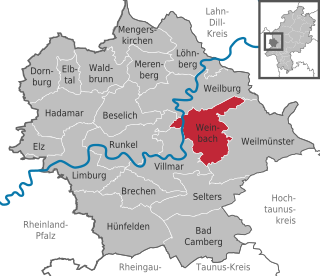
Limburg an der Lahn is the district seat of Limburg-Weilburg in Hesse, Germany.

Weilburg is, with just under 14,000 inhabitants, the third biggest city in Limburg-Weilburg district in Hesse, Germany, after Limburg an der Lahn and Bad Camberg.

Elz is a municipality in Limburg-Weilburg district in western Hesse, Germany, on the boundary with Rhineland-Palatinate.

Selters (Taunus) is a municipality with 8,000 inhabitants north of Bad Camberg in Limburg-Weilburg district in Hesse, Germany.

Merenberg is a municipality in Limburg-Weilburg district in Hesse, Germany.

Bad Camberg is, with 15,000 inhabitants, the second largest town in Limburg-Weilburg district in Hesse, Germany, as well as the southernmost town in the Regierungsbezirk of Gießen. It is located in the eastern Taunus in the Goldener Grund some 30 km north of Wiesbaden, 18 km southeast of Limburg an der Lahn, and 44 km northwest of Frankfurt, as well as on the German Timber-Frame Road. Bad Camberg is the central community of the Goldener Grund with good infrastructure, and a lower centre partly with a middle centre's function.

Hadamar is a small town in Limburg-Weilburg district in Hesse, Germany.

Hünfelden is a municipality in Limburg-Weilburg district in Hesse, Germany. Hünfelden lies on the Hühnerstraße, an historic part of Bundesstraße 417.

Weinbach is a municipality in Limburg-Weilburg district in Hesse, Germany.

Runkel is a town on the river Lahn in Limburg-Weilburg district in Hesse, Germany.

Weilmünster is a municipality in Limburg-Weilburg district in Hesse, Germany.

Brechen is a municipality in Limburg-Weilburg district in Hesse, Germany.

Löhnberg is a municipality north of Weilburg in Limburg-Weilburg district in Hesse, Germany.

Hundsangen is an Ortsgemeinde – a community belonging to a Verbandsgemeinde – in the Westerwaldkreis in Rhineland-Palatinate, Germany.

Dornburg is a municipality in the Westerwald in Limburg-Weilburg district in Hesse, Germany.

Elbtal is a municipality in Limburg-Weilburg district in Hesse, Germany.

Mengerskirchen is a municipality in Limburg-Weilburg district in Hesse, Germany.

Villmar is a market village and municipality in the Limburg-Weilburg district in Hesse, Germany. The community is the centre for quarrying and processing the so-called Lahn Marble.

Waldbrunn (Westerwald) is a municipality in Limburg-Weilburg district in Hesse, Germany.
Klarenthal Abbey is a former convent of the Order of Poor Ladies in the borough of Klarenthal in Wiesbaden, Germany. Klarenthal is the only abbey in present-day Wiesbaden.
































